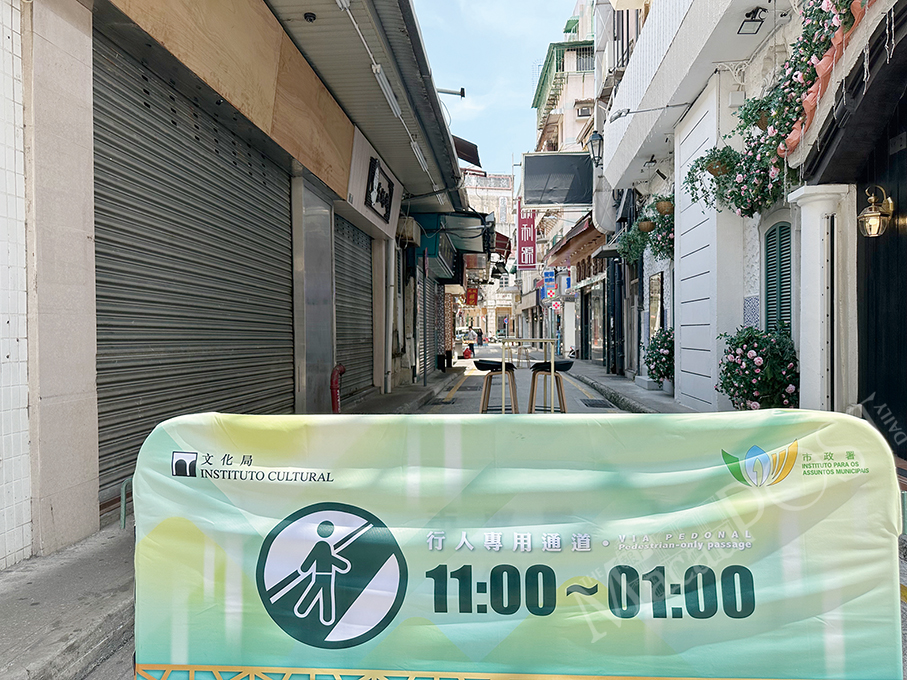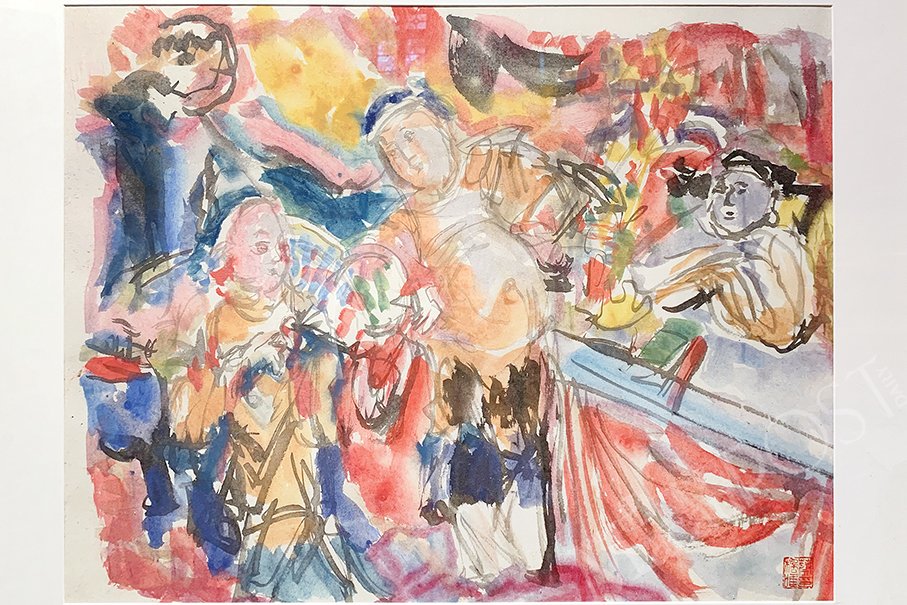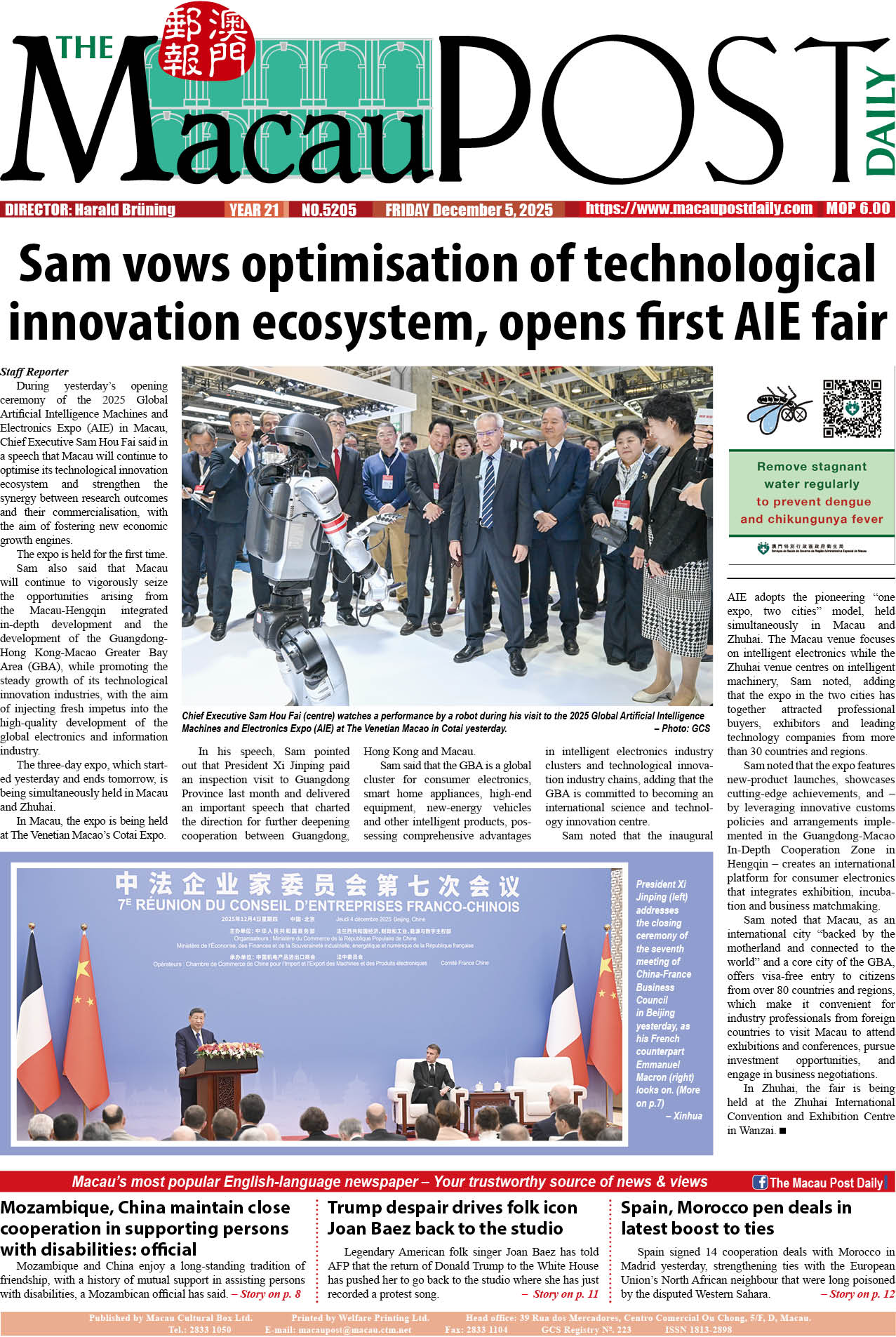IC mulls reopening part of pedestrian area to cars
The Rua da Felicidade pedestrianisation has been in operation for nearly a year, and yesterday lawmaker-cum-current affairs commentator Ron Lam U Tou quoted business operators in the area as saying that the vehicle traffic restriction has greatly affected the flow of people there, which has, in turn, hindered their business, hoping that the government could put an end to the street’s pedestrianisation and restore vehicular traffic in the area as soon as possible.
Lam made the remarks during an open-air meeting, which had been arranged previously, yesterday morning with journalists in the pedestrian precinct. Some of the area’s business operators also attended the gathering.
Lam also quoted the Cultural Affairs Bureau (IC) as saying that it would “seriously consider” opening Travessa do Aterro Novo, Rua do Matapau and Travessa do Mastroto to vehicle traffic again, but keeping Rua da Felicidade (“福隆新街”), as the pedestrian precinct’s core, closed.
The controversial pedestrianisation project, jointly launched by the government and integrated report operator Wynn Resorts on a trial basis on September 29 last year, covers the area between Rua da Felicidade, also known as the “Street of Bliss”, Travessa do Mastro, Travessa do Aterro Novo and Travessa de Ho Lo Quai, which are closed to vehicular traffic daily from 11 a.m. to 1 a.m. the following day except for permitted vehicles.
When the project was first announced last year, IC President Leong Wai Man said that the pedestrianisation aimed to take Rua da Felicidade as the core, actively explore, expand and integrate the cultural resources of the surrounding streets, and link up with the surrounding core tourism districts, such as Avenida de Almeida Ribeiro, Largo do Senado and Largo de Santo Agostinho, to create a vibrant leisure and tourism experience with a good arts and cultural ambience and a comfortable walking environment and, at the same time, inject attractions such as cultural and commercial activities, arts and cultural performances and art installations, as well as casual dining to attract foot traffic and drive the popularity of shops in the area. Leong also said in April this year that during the trial run in the previous few months, the foot traffic in the area had been on the rise, showing the gradual improvement of the business environment there, adding that the bureau had received views from the area’s business operators hoping that Rua da Felicidade would become a long-term pedestrian precinct.
Secretary for Social Affairs and Culture Elsie Ao Ieong U has said that regarding the setting-up of a pedestrian precinct in Rua da Felicidade, the government had conducted a survey showing that 95 percent of the households and commercial tenants did not object to the project, among whom nearly 80 percent were in favour of the project, while only five people were opposed to it.
After the meeting, Lam sent petitions to Chief Executive Ho Iat Seng and chief executive candidate Sam Hou Fai, together with the signatures of 41 shop operators in the precinct, urging the government to end the trial run of the Rua da Felicidade pedestrianisation project and axe its plan to turn it into a long-term scheme.
Lam noted that the pedestrian precinct has been implemented on a trial basis for a year, during which the ban on vehicular access has caused inconvenience to shop operators and even affected their businesses, quoting some of the area’s business operators as saying that their takings have been worse than before the implementation of the pedestrianisation project in the past year as even regular consumers reduced their spending in shops due to inconvenience caused by the measure, with some restaurateurs saying that their business has dropped by at least 20 percent on average, while some said that they have the “obvious” feeling that the people flow in the section between Avenida de Almeida Ribeiro and Rua dos Cules is down compared to before the pedestrianisation.
Lam went on to say that the pedestrian precinct failed to boost the community economy there: “They [visitors] usually just ‘check in’ and join in the fun but seldom spend money there”, also expressing the business operators’ concern that as the government has always claimed publicly that the pedestrian precinct is very effective, its foot traffic has increased and a number of new shops have moved in, landlords have got the wrong idea that they could increase their rents.
In the letters, Lam also said that the frequent replacements of large-scale installations in the pedestrian precinct due to different festivals, in addition to deterring people from entering the area by giving them the wrong impression that roadworks were being carried out there, the installations have also blocked some shops’ signboards and façades, resulting in even less pedestrian flow where street lighting was, anyhow, already inadequate, suggesting that the government should focus on improving the street environment and restoring the façades of the buildings on Rua da Felicidade in the context of its community revitalisation drive, reducing the number of large-scale installations and the number of light decorations hanging above the street, while preserving the original historical architectural features of Rua da Felicidade.
Reporters spoke with several business operators in the pedestrian precinct yesterday. The owner of Sai Nam Restaurant, surnamed Tong, said she hoped that the government could at least shorten the duration of the precinct’s vehicular traffic restriction, adding she believed that the cancellation of vehicular traffic restrictions could ease the flow of vehicles in Avenida de Almeida Ribeiro – the city’s main thoroughfare – and tackle traffic congestion there.
The person-in-charge of Lai Kei Restaurant, surnamed Ip, admitted that the initial implementation of the project did help boost turnover thanks to the promotion by influencers on the internet, but the impact had been “transient” only, while business has been poor ever since, lasting for nine months. He urged the government, in conjunction with the city’s integrated resort operators, to provide shuttle bus services between the Barrier Gate checkpoint and the pedestrian precinct. Concerning the issue that Rua dos Mercadores is not well lit at night and the whole street is dark and “gloomy”, Ip suggested the government improve public lighting there in order to increase the area’s foot traffic.
Chan, who is about to set up a retail business on Rua da Felicidade, said that he was worried that his upcoming business will be affected by the possible reduction in vehicular traffic restrictions which, he said, could result in competition between pedestrians and vehicles for road space, hoping that the government would balance the views of both sides, i.e., those for and against the pedestrianisation project, or set up pick-up and drop-off areas in the periphery instead.
IC President Leong Wai Man yesterday morning visited the Rua da Felicidad pedestrian precinct to understand the views of its business tenants, and Lam quoted Leong as saying that the bureau would study optimising the scope and time slots of the pedestrian precinct and strive to remove the traffic restrictions in Travessa do Mastro, Travessa do Aterro Novo, Rua do Matapau and Travessa de Ho Lo Quai in the near future, adding that the bureau has set up a WeChat group with the area’s business operators and residents to communicate and express their views directly to the bureau.

Lawmaker-cum-current affairs commentator Ron Lam U Tou (left), accompanied by his assistant (second from left) and some of the pedestrian precinct’s business operators, speaks to the media about their concerns about the vehicle traffic curbs affecting their businesses after the pedestrianisation of Rua da Felicidade.

This photo taken yesterday shows Travessa do Mastro being closed to vehicular traffic between 11 a.m. to 1 a.m. the next day.

A motorbike is ridden along Rua da Felicidade yesterday morning before the vehicular traffic closure at 11 a.m. – Photos: Yuki Lei









